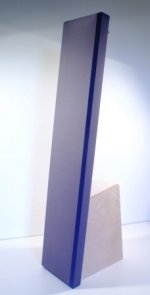Hi,
in additon to the need of a flat response, my experience tells me that two systems with identical frequency response sound different depending on their radiation pattern.
A highly directive panel (flat panel, no segmentation) tend to sound more harsh than segmented or bowed stators due to high energy densitiy bundled on a limited axis. I think a well selected dispersion into the room is the key.
Regarding membran stretching and fundemental resonance:
I measured ML's vantage and was very astonished to see that the panel performs down to its fundemental resonance. Although ML put a lot of work into controlling the resonance frequency you can hear that the panel runs into resonance frequency. Imo this range (about 400Hz) sounds rough, uncontrolled and overleveled.
I agree with Calvin: The cross over should be at least one octave above the resonance (depending on filter charateristics). E.g. my midsize panel has a resonance of 90 hz and crossover is (270Hz/18dB). This is more than enough headroom and believe me, it sounds clear and crisp without any compromise.
Attached is a picture of my full-active hybrid-ESL
Capaciti
in additon to the need of a flat response, my experience tells me that two systems with identical frequency response sound different depending on their radiation pattern.
A highly directive panel (flat panel, no segmentation) tend to sound more harsh than segmented or bowed stators due to high energy densitiy bundled on a limited axis. I think a well selected dispersion into the room is the key.
Regarding membran stretching and fundemental resonance:
I measured ML's vantage and was very astonished to see that the panel performs down to its fundemental resonance. Although ML put a lot of work into controlling the resonance frequency you can hear that the panel runs into resonance frequency. Imo this range (about 400Hz) sounds rough, uncontrolled and overleveled.
I agree with Calvin: The cross over should be at least one octave above the resonance (depending on filter charateristics). E.g. my midsize panel has a resonance of 90 hz and crossover is (270Hz/18dB). This is more than enough headroom and believe me, it sounds clear and crisp without any compromise.
Attached is a picture of my full-active hybrid-ESL
Capaciti
Attachments
Please forgive my strong views on this: Designers of ESLs (or any planar speaker) MUST address the problem of beaming, one way or another, if they expect anything deserving the term “high fidelity”. Anytime a radiator is large compared to the wavelength of sound it reproduces, there will be beaming. The on-axis frequency response of a panel without equalization will increase as frequency rises, while the dispersion angle narrows, with lots of sidelobes to boot. The resultant response can indeed sound harsh and will require sitting in a tiny sweet spot to hear any highs. Sitting slightly off axis won’t correct the problem properly. If you insist on using a single large radiator at all frequencies, you can consider equalization (per Sanders, et al), but then you’ll have a very dead room response. IMO, ESLs must address this problem by one of several means: segmentation (a la Acoustat), tweeter strips (a la Quad 57), delays (a la Quad 63), facets (a la Sound Lab) or curvature (a la Martin Logan). A lot of DIY designs seem to ignore the problem, and I imagine many DIYers wonder why their sound is so thin, harsh and piercing. And never mind dipole cancellation for the moment… Making a flat responding ESL is not trivial and is far more involved than just making a nice panel. OK, getting off my soap box now…
Hi,
Thanks for help.
I will have to find a microphone ; i have read that some elecret mics are suitable to measure frequency response.
I was also thinking to use some kind of material to damp the resonant frequency.
Generally , i think it would be the best to push ESL down to ,lets say , 100 - 120Hz , and use a sub to drive the lowest frequencies.
I think that using additional woodden "wings" to decrease dippole cancellation could help , but this grealty increases size of ESL.
Regards,
Lukas
Thanks for help.
I will have to find a microphone ; i have read that some elecret mics are suitable to measure frequency response.
I was also thinking to use some kind of material to damp the resonant frequency.
Generally , i think it would be the best to push ESL down to ,lets say , 100 - 120Hz , and use a sub to drive the lowest frequencies.
I think that using additional woodden "wings" to decrease dippole cancellation could help , but this grealty increases size of ESL.
Regards,
Lukas
Whats best?
Hi,
it´s an often to find failure of ESL-beginnners to try to squeeze the last out of the panel with regard to low freqs. This might only be useful with fullrange ESLs. As soon as You plan any form of hybrid -for reasons of size and dynamics- You should aim or highest efficiency. This leads to high Fs-panels. With resonances around >100Hz You´ll gain enough efficiency and dynamics to compare to dynamic speakers, but You shouldn´t consider crossover-freqs below 200-300Hz. With panels below 40cm in width You´d have to equalize the response up to 1kHz too much anyway.
jauu
Calvin
Hi,
it´s an often to find failure of ESL-beginnners to try to squeeze the last out of the panel with regard to low freqs. This might only be useful with fullrange ESLs. As soon as You plan any form of hybrid -for reasons of size and dynamics- You should aim or highest efficiency. This leads to high Fs-panels. With resonances around >100Hz You´ll gain enough efficiency and dynamics to compare to dynamic speakers, but You shouldn´t consider crossover-freqs below 200-300Hz. With panels below 40cm in width You´d have to equalize the response up to 1kHz too much anyway.
jauu
Calvin
- Status
- Not open for further replies.
